The 8 best ways to promote affiliate links in 2024
By Phil Norris May 2, 2024
Affiliate marketing has grown from a niche pursuit into one of the most popular ways for content creators to monetize their online audience. Indeed, one in three publishers say affiliate marketing is in their top three revenue sources, while one in 10 say it’s their #1 revenue stream.
But you’re not going to make any money as an affiliate if you can’t find an effective way to get your affiliate links in front of as many people as possible.
So what’s the best way to promote affiliate links?
To answer that question, we’re going to round up eight of our favorite promotional strategies, each backed by real-world examples from successful affiliate publishers.
Let’s get into it…
How affiliate links work
Before we start discussing where to post affiliate marketing links, it’s worth explaining how those links actually work.
When you join an affiliate program, your affiliate partner (i.e. the brand whose products or services you’re promoting) allows you to generate your own affiliate links — unique referral links that point toward key pages on the brand’s website.
When someone clicks your affiliate link and buys something, the information in the link proves that you played a key role in the path to purchase. So your affiliate partner will reward you with a commission. Nice!
Here’s a more detailed look at how it all works:
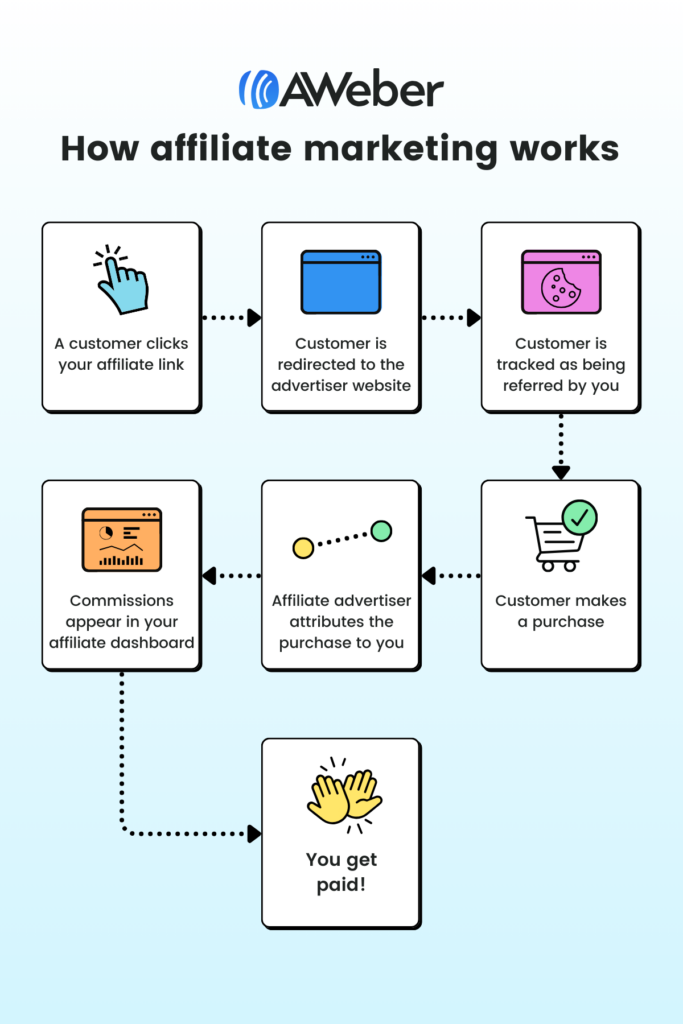
- You share an affiliate link with your audience via a blog, email newsletter, social media post, or some other method.
- A customer likes what they see and clicks your affiliate link to find out more.
- The link takes the customer to your affiliate partner’s website.
- Cookie tracking technology shows that the customer clicked one of your affiliate links.
- The customer buys something from your affiliate partner.
- Your affiliate partner attributes the sale to you and pays you a commission.
How to promote affiliate links
Now that we’ve discussed the theory behind affiliate links, let’s dive into our top strategies for promoting them:
1 – Send email newsletters
Given that email marketing delivers a return of $36 for every $1 spent, sending newsletters is arguably the single best way to promote affiliate links.
The biggest benefit of newsletter marketing is that it gives you total control over who sees your content and when. No relying on search or social media algorithms; you can land in your subscribers’ inboxes whenever you like.
Meanwhile, the only real downside is that it can take a little time to grow your email list. But you can accelerate that process with some smart marketing.
Tips for promoting affiliate links in product reviews
Golf Span is one of many affiliate sites that uses email marketing to promote its affiliate links.

Let’s take a look at some of the tactics they use:
- Add a compelling hook to your email capture form to grow your marketing list fast. For instance, Golf Span promises to help people increase their drive distance — a common goal of anyone looking to improve their golf game.
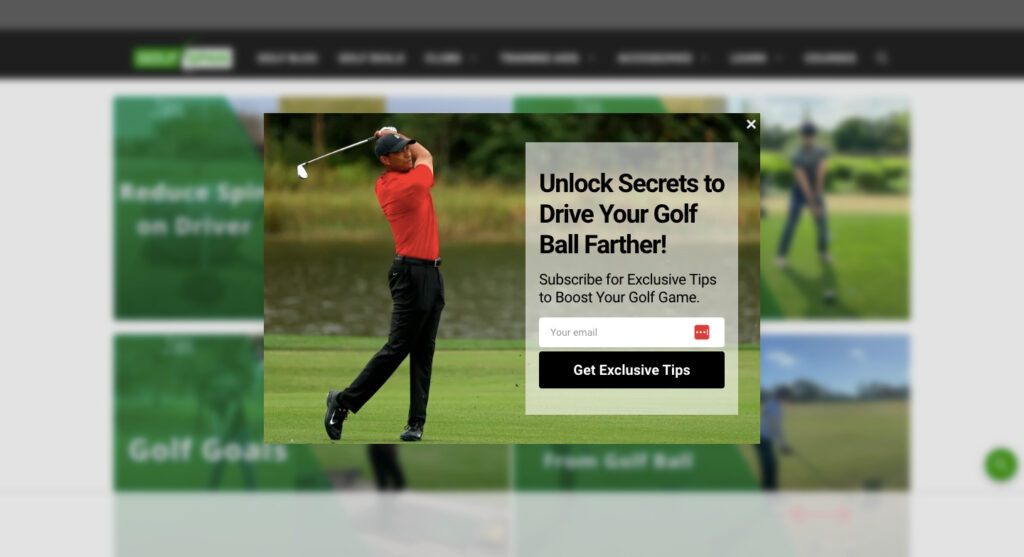
- Give people a reason to open your emails by crafting compelling subject lines promising some kind of value. Golf Span often uses its subject lines to promote the savings on offer, without giving away too much information.

- No need to send readers to your website; you can add affiliate links within your email newsletters to streamline the path to purchase.

👉 Learn more: 13 Ways to Build Your Email List For Free
2 – Create an online course
As we explained in our guide on how to be a successful affiliate marketer, there’s one affiliate link promotion strategy that we’d recommend time after time — and it’s surprisingly underutilized.
It involves creating your own online course.
At this point, you’re probably thinking: “How on earth does building a course help me promote affiliate links?”
Here’s the answer:
- Start by finding a common pain point your audience is eager to overcome.
- Create an online course designed to help people tackle that pain point.
- Use the course to recommend specific products and services that relate to your target pain point (e.g. if you’re helping people to promote an online business, you might recommend a marketing tool like AWeber).
- Every time you mention a product or service, add an affiliate link so you get paid for any sales you generate.
- Promote your online course far and wide!
This strategy works like a dream because the people who sign up for your course have come to you for answers. When you tell them a specific product can help them resolve their pain point, there’s a good chance they’ll listen.
Tips for promoting affiliate links in an online course
Marketing education brand Legendary Marketer is the absolute master of using a (paid) online course to promote a bunch of affiliate links. Let’s dig under the hood and see how they do it:
- Identify a pain point with broad appeal, then build your course around it. For instance, Legendary Marketer has created a course to help people start a profitable online business, which is one of the biggest goals for its audience.
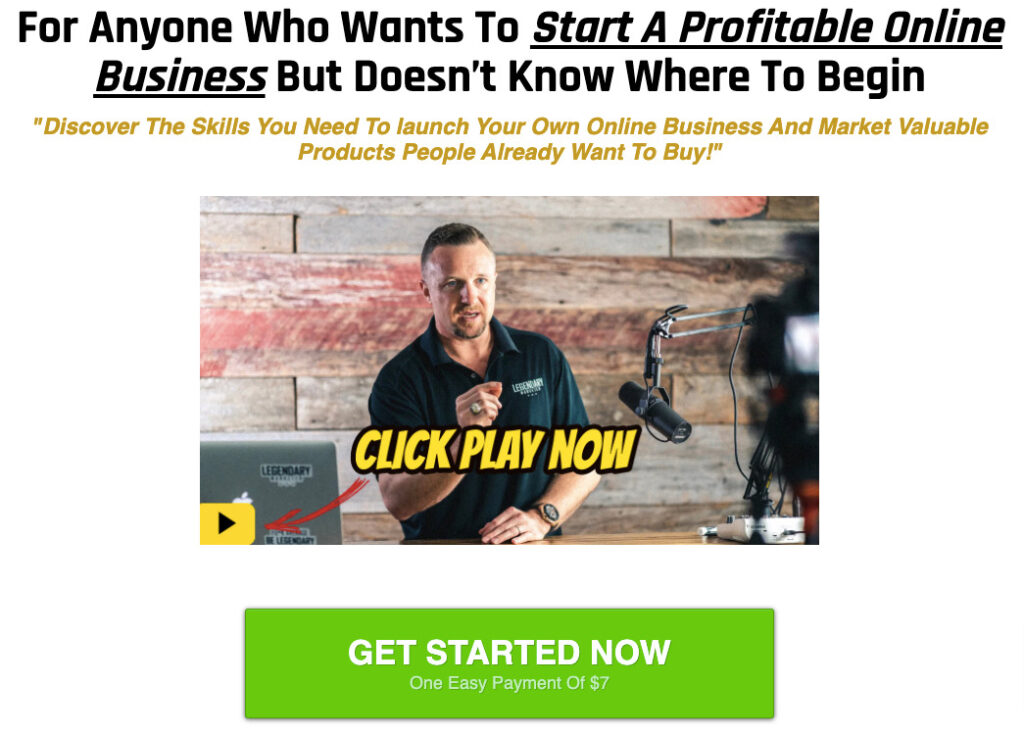
- Funnel website visitors toward your course content using prominent CTAs. Even though Legendary Marketer sells a wide range of courses, its homepage CTAs are all about promoting the same course on starting an online business:
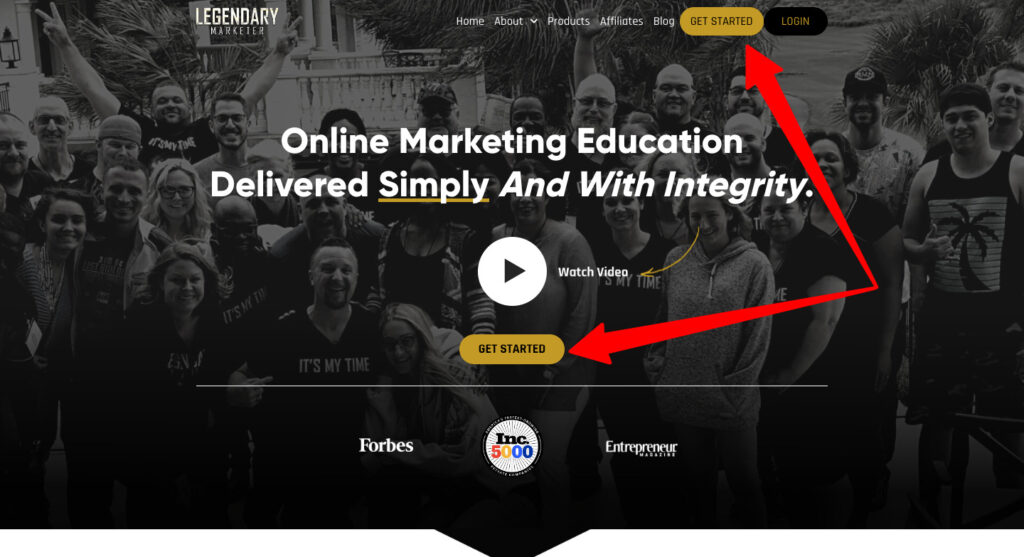
- Charge a (small) fee for your online course. This step is optional — but if customers are prepared to hand over money for your content, that’s a good sign they trust you. Which, in turn, means they’re more likely to buy your recommended products.
3 – Write product reviews
Product reviews are one of the most effective ways to promote affiliate links.
Why? Because writing product reviews allows you to target audiences who are close to purchasing.
Someone searching on Google for a term like “Stanley Cup review” is clearly already thinking about buying a Stanley Cup — they’re not reading reviews for fun. So if you can persuade them that a Stanley Cup is worth buying (or point them toward a cheaper and/or better alternative), you’re well on your way to driving affiliate link clicks and sales.
Tips for promoting affiliate links in product reviews
NBC News was one of countless publishers to latch onto the Stanley Cup trend by writing its own product review:
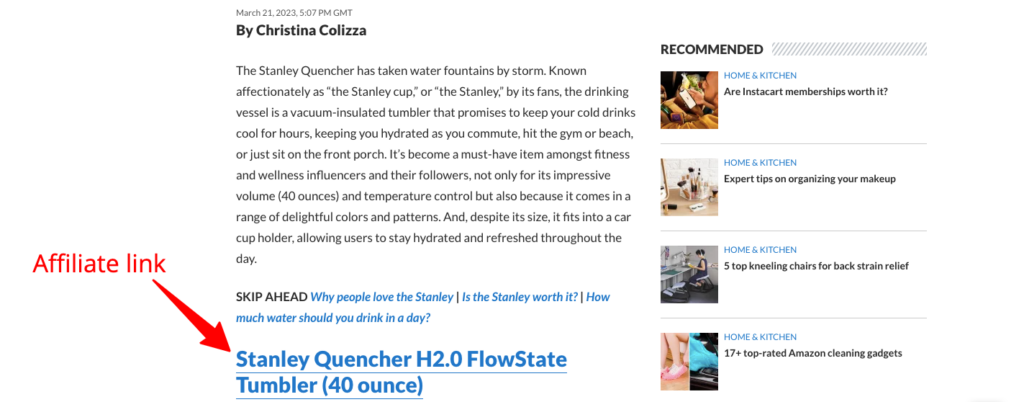
Here are some of the ways they use product review content to share affiliate links:
- NBC adds prominent CTAs to product reviews, making it easy for readers to click straight through to the retailer of their choice and make a purchase. Of course, each of those CTAs incorporates an affiliate link:

- Share personal experiences of you actually using the product to demonstrate that your review is worth listening to. For example, NBC’s reviewer shares this scintillating anecdote about how she tested Stanley’s claim that it keeps drinks cold for up to 11 hours:

- If you’re recommending a product, make sure you reference specific features and benefits so your words are more meaningful and persuasive, like NBC did here by discussing the Stanley Cup’s various lid positions:

4 – Compare 2+ different products
A twist on the classic product review is to create comparison content that pits two or more products against one another. They typically target users searching for phrases like “{product A} vs {product B}”.
These articles are aimed at people a little higher up the buyer funnel than a traditional product review, because the customer hasn’t yet singled out a single product.
But that’s not necessarily a bad thing, because comparison articles allow you to recommend multiple products at the same time, potentially helping you convert a broader audience than with a product review.
Tips for promoting affiliate links in comparison articles
Stock Photo Secrets publishes a ton of affiliate content, much of which helps people choose the right graphic design tools for their needs. Just like this comparison piece that pitches Canva against Figma:

Here are some of the ways they use comparison content to promote affiliate links:
- Explain who should use each product. This tactic is especially effective if you’re comparing products with slightly different value propositions, features, and audiences.

- Comparison articles aren’t the place for in-depth reviews of the products you’re analyzing, so be sure to add links to supplementary content so readers can find out more about their preferred option:

- What if the products you’re comparing aren’t a great fit for every potential buyer? In that case, be sure to recommend some relevant alternative products (and, if possible, add links to your reviews of those alternatives).

5 – Create buying guides
Whereas product reviews are all about sharing links to one specific product and comparison pieces tend to focus on 2-3 different options, buying guides give you the opportunity to link to multiple products within a specific category or use case.
Buying guides fall into two main categories:
| Buying guide type | Purpose | Example |
| Best {product type} | Target a broad audience | Best gaming chair |
| Best {product type} for {use case/pain point} | Reach a niche audience showing high buying intent | Best gaming chair for back pain |
As with any type of marketing content, focusing on a more niche target audience reduces your traffic potential. But anyone who does find your content is likely to be more qualified — and, therefore, more likely to buy.
Tips for promoting affiliate links in buying guides
PC Gamer regularly writes articles rounding up the best gaming peripherals, accessories, hardware and software in specific categories, like this one on the best gaming chairs of 2024…

Let’s break down some of the link promotion methods they use within buying guides:
- The more your content speaks to specific audience pain points, the more readers will click your affiliate links (and hopefully buy something). So be sure to explain who should (and shouldn’t) buy each product, like PC Gamer does here:

- Give users an at-a-glance view of your product picks — because not everyone wants to wade through thousands of words to reach a buying decision. PC Gamer does this by adding a brief synopsis of each product at the top of its buying guides (plus CTAs to buy the products on various e-commerce sites and marketplaces):

- Let readers know why they should trust your product recommendations. To do this, you need to demonstrate your subject-matter expertise, like PC Gamer editor Jacob Ridley does here:

6 – Add affiliate links to YouTube captions
All the methods we’ve shared so far require you to have some sort of central “hub” (AKA a website or blog) to reach your audience.
But what if you want to know how to promote affiliate links without a website?
Of all the available options, we reckon your best bet is to start a YouTube channel.
While most people think of it as a streaming platform and/or social media site, YouTube is also the world’s second largest search engine, with 2.5+ billion logged-in users accessing it every month. In other words, YouTube effectively gives you two different ways to reach your audience:
- Through algorithmically generated content recommendations
- By targeting the types of keywords people search for on YouTube
Tips for promoting affiliate links on YouTube
When it comes to leveraging the power of YouTube for promoting affiliate links, Garage Gym Reviews is up there with the very best. It’s built a community of 500,000+ followers on YouTube, and most of its content incorporates affiliate links within the video descriptions:

Here are some of the tactics they use to promote affiliate links on YouTube:
- Perform YouTube keyword research to find the types of terms your audience are searching for. You can do this by entering a seed keyword (like “home gym”) in a YouTube-specific keyword tool like TubeRanker.

- Showcase products in a way that resonates with your target audience. For instance, Garage Gym Reviews is specifically targeting people who want to build or improve a home gym, so it always demonstrates products in use in a household setting rather than a professional gym.

- Add CTAs to subscribe to your YouTube channel and follow you on other social platforms at the end of your videos. The more often people see your content, the more likely they are to click your affiliate links!
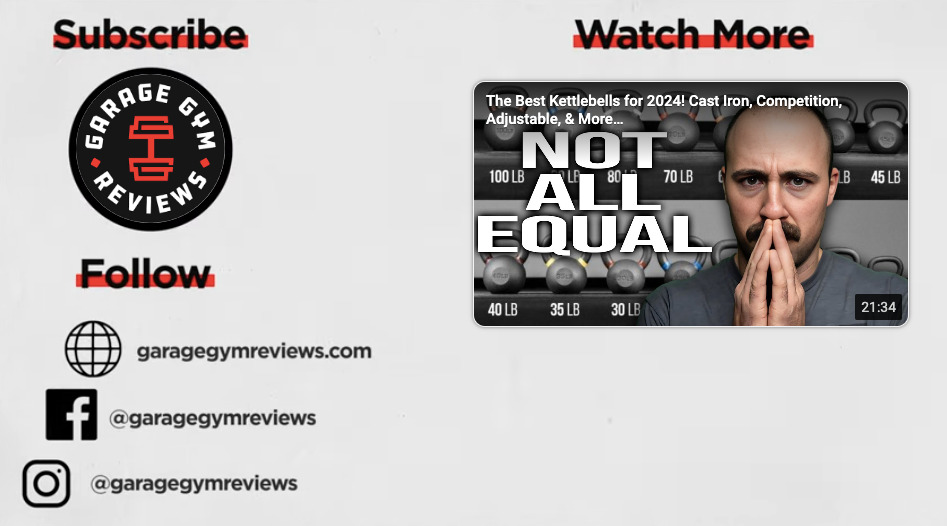
7 – Share affiliate links on Pinterest
You might be surprised at the social media platforms we have (and haven’t) included in this article.
Sure, YouTube’s a huge deal. But why Pinterest? And why no Instagram or TikTok?
Well, firstly, Insta and TikTok didn’t make the grade because they make it too difficult to share affiliate links, with no links allowed in post descriptions or comments.
And then there’s the fact that, while Pinterest certainly isn’t the biggest social network, it has excellent organic reach and comparatively low competition in many affiliate niches. Not only that, but almost half of weekly Pinterest users have discovered a new brand or product on the platform, so it’s also a popular source of shopping inspiration.
Tips for promoting affiliate links on Pinterest
Lantern Lane Designs generates almost five million monthly views on Pinterest. They put all that visibility to good use by linking from their Pinterest posts to affiliate content on their website:
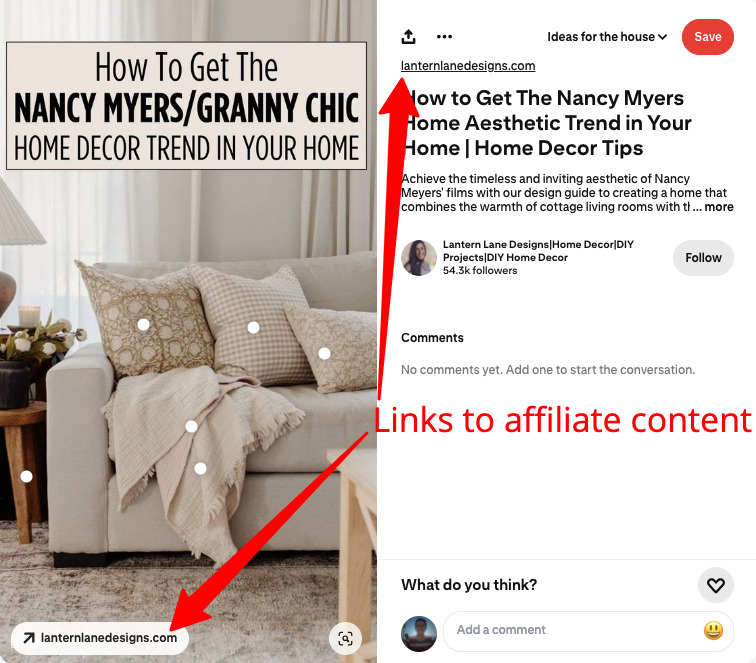
Here are some of the affiliate link promotion tactics they use:
- Like YouTube, Pinterest is part social media site and part search engine, so take the time to seek out relevant keywords using the platform’s autocomplete functionality, then add those terms to your post titles and descriptions.

- While we generally recommend keeping the path to conversion as short and sweet as possible, Lantern Lane Designs adds links to blog posts rather than linking directly to affiliate products. This approach might lead to fewer initial conversions, but it also makes it easier to build a trusted brand — and higher trust leads to more sales down the line.

- Don’t be afraid to promote the same content more than once. Sure, you can’t try to game the system by creating lots of Pinterest accounts, but you can absolutely create several pins to steer people toward a single blog post.

8 – Include affiliate links in podcast show notes
Podcast listenership has sky-rocketed in recent years, with 42% of Americans now listening to at least one podcast per month — triple the figure from a decade earlier.
Now, I know what you’re thinking: podcasts are, first and foremost, an audio medium. Which means they’re not the most obvious choice for sharing affiliate links. However, plenty of affiliates are seeing success by adding links to their podcast show notes.
While this approach is unlikely to convert many (or any) people who just happen to stumble across your show notes, it’s a highly effective way to drive sales from existing podcast listeners. And the added benefit is that these people actively choose to listen to your content, which suggests they’re at least somewhat likely to respect your product recommendations.
Tips for promoting affiliate links in podcast notes
Sahara Rose, host of the Highest Self Podcast, often uses the show’s notes section to share relevant affiliate links and discount codes:
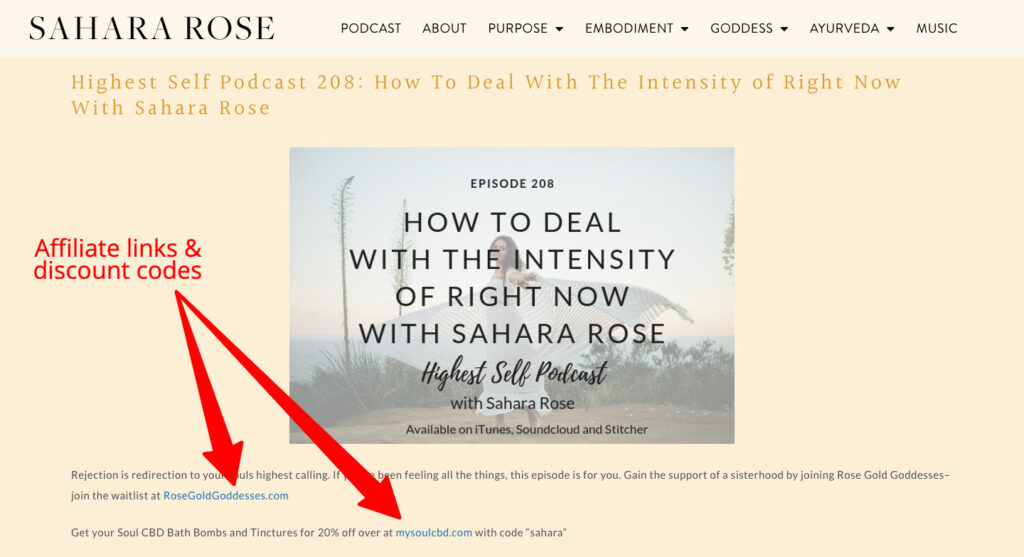
Here are some of the promotional strategies she uses:
- Tell listeners that you’ll be adding product links to the show notes so they know where to look. You don’t necessarily have to explain that they’re affiliate links within the podcast, but you should definitely disclose it in the show notes.
- Create a “resources” section within your show notes and use it to steer people toward your affiliate links (plus any other useful content you want to link to).
- Share your latest episode on social media to get more ears and eyes on your podcast and show notes. Choose the most relevant platform(s) for your audience — for instance, Sahara Rose links to her latest podcast episode in her Instagram bio:
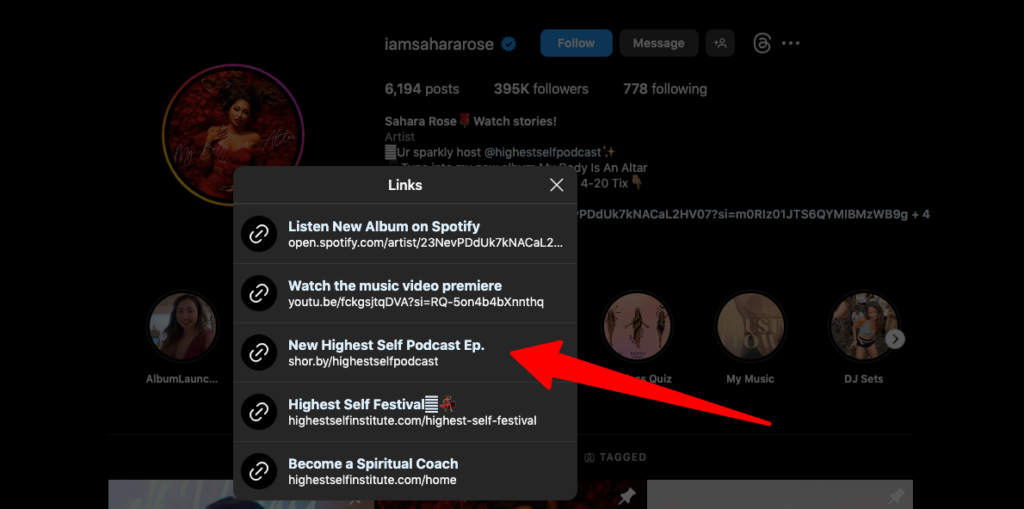
Get more eyes on your affiliate links with AWeber
We’ve shared eight different strategies for promoting affiliate links in this article.
But in reality, if you’re going to succeed as an affiliate marketer, you’ll likely have to combine several (or perhaps even all) of those strategies. Because you don’t want to rely on a single channel to generate all your traffic, clicks, and sales.
All of which means that you’ll definitely need an email marketing tool in your corner — and AWeber is hard to beat.
With our huge library of templates, our intuitive drag-and-drop email builder, and our AI writing assistant, we make it super simple to craft high-converting newsletters to house your affiliate links.
See for yourself by signing up for your free AWeber account today!
And when you’ve seen how great we are, why not get paid for recommending us to your audience by joining the AWeber affiliate program?
 87% off ends soon!
87% off ends soon! 
